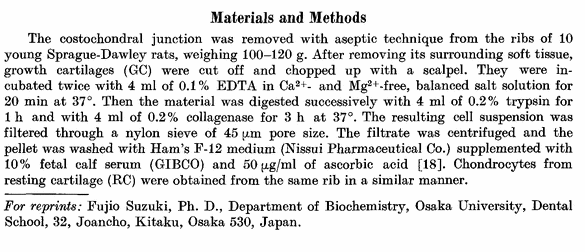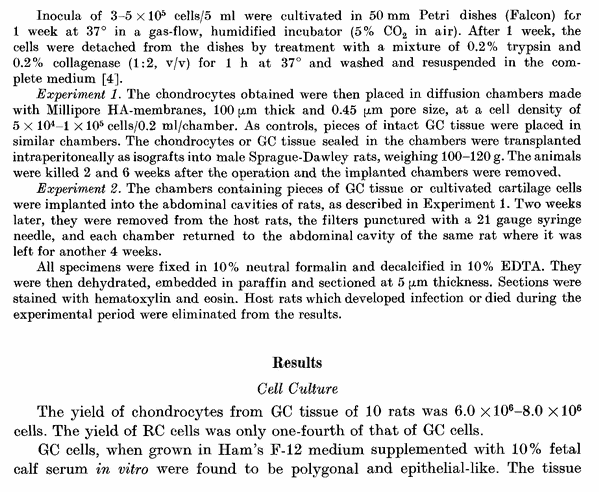Update 2/12/2013: It would seem that I no longer can access through the link below to the full text/article without paying for it. This means that my ability to do research and learn more has been severely limited. Only a quick study from the abstract and introduction seems to be possible at this point.
From a paper/article of a study from SpringerLink “Osteogenesis by chondrocytes from growth cartilage of rat rib“.For the Full Article click HERE…
Chondrocytes were isolated from growth cartilage and resting cartilage of rat rib and cultivated in vitro. The cultivated chondrocytes were placed in Millipore diffusion chambers, which were then implanted into the abdominal cavities of rats for several weeks and prepared for histological analysis. The results indicate that growth cartilage cells have a remarkable osteogenic potential, even after cultivation in vitro, whereas resting cartilage cells show no osteogenic activity. However, growth cartilage cells alone do not form new bone but require the participation of certain host cells to initiate osteogenic differentiation.
Introduction
The process of replacing cartilage by bone is known as endochondral ossification. During the first stages of conversion into bone, epiphyseal cartilage cells
increase their rate of proliferation, enlarge, and become hypertrophic. It has been assumed in the past that the hypertrophic cells undergo degenerative changes and death [1, 2, 3, 8, 17, 22]. However, Holtrop, on the basis of experimental transplantation of growth cartilage labeled with 3H-thymidine [10, 11, 12], suggested that some of the cells survive and redifferentiate in the metaphysis to contribute to ossification. Shimomura and Ray have confirmed her findings that hypertrophic chondrocytes can survive and transform into bone-forming cells [19 ]. Recent investigations using electron microscopy have led to opposing interpre-
tations [3, 13, 14, 20], and controversy persists concerning the mechanism of endochondral ossification.
In the present study, hondrocytes isolated from growth cartilage of rat rib were cultivated in vitro and transplanted to investigate the mechanism of endo-
chondral ossification.
The reason why this article/study/paper is important is to show why it is more important to focus on the cartilage of the plate, then the bone area. We have sen in the past ideas like using Low Intensity Pulses Ultrasound (LIPUS) to possibly increase height, but from my own limited research so far it seems that any method or technique to increase the rate of bone growth or bone density will not do anything for our intention to grow taller ie. increase the length of the long bone in our body. Remember that commercial pills and supplements that are purported to be able to increase bone growth are true, but they don’t increase bone in the way we want. The bone growth happens inside the bone, often making the medullary cavity thinner and smaller, making the cortical bone layer thicker. Bone growth pills are sold as a way to treat or prevent bone degeneration in older people who might get osteoporosis.
LIPUS has been shown through maybe 1-2 PubMed studies to increase the rate of bone healing in distraction osteogenesis surgeries, but without the initial distraction, bone growth will not lengthen bone, at least within physically mature humans with no epiphyseal cartilage to widen and lengthen.
From the abstract, we learn that overall, the epiphyseal cartilage derived chondrocytes are special, diffierent from what we would find in other cartilage explants, like from the resting cartilage. When grown in the lab (in vitro) we find that the cartilage cells themselves already have bone creating properties.
It seems epiphyseal cartilage will always ultimately turn into bone in some way, whether through calcification, vascularization, etc. This suggest that when we are looking for a method to legnthen bone, we don’t really have to worry about the process of osteogenesis, but only have to worry about chondrogenesis. If we get the chondrocyte and cartilage formation correct from using growth plate derived cells, the osteogenesis and bone formation seems to automatically occur given time, and the right nutrients getting in, when the cultured cartilage or chondrocytes are finally implanted back into the subject.
Another thing that might be important to take away from the introduction is that maybe not all the hypertrophic chondrocytes in the hypertrophic zone of the growth plate completely die out through degeneration. Some researchers have suggested that the hypertrophic chondorcyte can actually differentiate even further going down deep into the calcification/ossification layer and turn into osteocytes/osteoblasts which start forming bone cells and bone elements.
So the big take-way from this article is to focus less on bone creation, osteogenesis, but focus more attention on cartilage formation, chondrogenesis.


